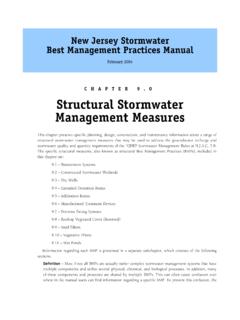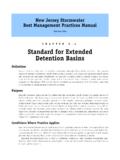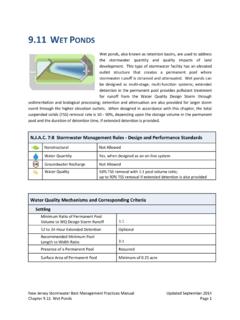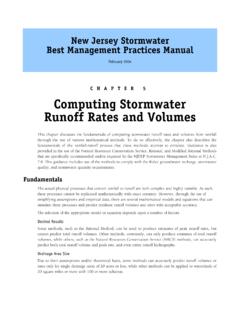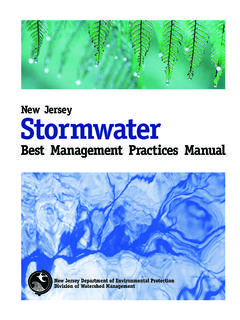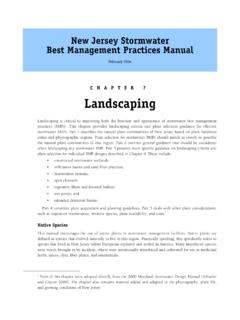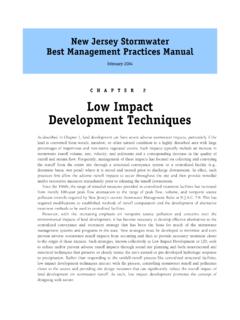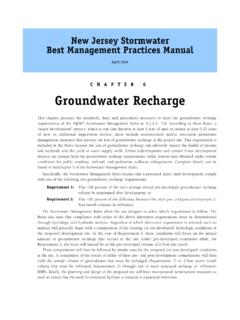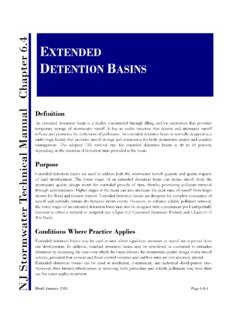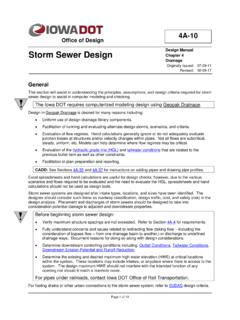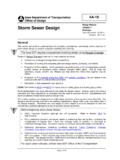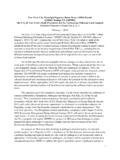Transcription of 9.9 SAND FILTERS - njstormwater.org
1 sand FILTERS . A sand filter is a stormwater management system designed to maximize the removal of pollutants from stormwater. It consists of a pre-treatment zone and a treatment zone, which includes the sand bed, and in underdrained systems, and the underlying components. Pollutants are treated through settling, filtration, and adsorption by the sand bed. The total suspended solids (TSS) removal rate is 80%. 7:8 Stormwater Management Rules - design and Performance Standards Nonstructural Strategy Not Allowed Water Quantity Yes, when designed as an on-line system Groundwater Recharge Yes, for systems designed to infiltrate into the subsoil Water Quality 80% TSS.
2 Water Quality Mechanisms and Corresponding Criteria Settling Storage Volume Entire Water Quality design Storm Volume Filtration sand bed minimum thickness 18 inches Maximum storage above sand bed 24 inches Maximum design permeability rate of sand bed 2 inches/hour Minimum top soil permeability rate, Underdrained Systems: if using optional vegetative cover 2x the hydraulic head loss of the underdrain, or Systems Designed to Infiltrate: 2x the permeability of the subsoil New Jersey Stormwater Best Management Practices manual Updated September 2014. Chapter sand FILTERS Page 1. Introduction A sand filter is a stormwater management facility that uses sand to filter particles and particle-bound constituents from runoff.
3 There are two types of sand filter systems: infiltration sand FILTERS and underdrained sand FILTERS ; pollutant removal occurs solely in sand bed in both types of systems. Stormwater entering the sand filter is first conveyed through the pretreatment zone where trash, debris and coarse sediment are removed. It then passes through the treatment zone and out of the system through either an outlet pipe, in an underdrained system, or through the subsoil via infiltration. Pollutants in runoff are treated in sand FILTERS through the processes of settling, filtration and adsorption. Due to the potential for groundwater contamination, the use of sand FILTERS designed to infiltrate into the subsoil, and all stormwater infiltration best management practices (BMP), is prohibited in areas where high pollutant or sediment loading is anticipated.
4 For more information regarding areas where stormwater runoff infiltration is prohibited, refer to 7 (a)2ii. sand FILTERS are better suited for impervious drainage areas with high TSS, heavy metals and hydrocarbon loadings like roads, driveways, drive-up lanes, parking lots and urban areas. They are not recommended for use in pervious drainage areas where high sediment loads and organic material can clog the sand bed; where such loadings cannot be avoided, pretreatment is recommended. sand FILTERS must have a maintenance plan and should be protected by easement, deed restriction, ordinance or other legal measures that prevent its neglect, adverse alteration or removal.
5 Applications sand FILTERS may be designed to convey storm events larger than the Water Quality design Storm; however, regardless of the design storm chosen, all sand FILTERS must be designed for stability and capacity in accordance with the Standards for Soil Erosion and Sediment Control in New Jersey, as required by 7:8 Stormwater Management rules. sand filter systems designed to infiltrate into the subsoil may be used to meet the groundwater recharge requirements. For more information on computing ground water recharge, see Chapter 6: Groundwater Recharge. To receive credit for a TSS removal rate of 80%, sand FILTERS must be designed to treat the Water Quality design Storm and in accordance with all of the following criteria.
6 New Jersey Stormwater Best Management Practices manual Updated September 2014. Chapter sand FILTERS Page 2. design Criteria Basic Requirements As previously stated, there are two types of sand FILTERS . The following illustrations depict the basic components of both types of sand FILTERS and the various zones through which stormwater travels. Profile View sand filter Basics Plan View sand filter Basics The following design criteria must all be met in order to receive the 80% TSS removal rate for this BMP. It is critical that all sand FILTERS are designed in accordance with these criteria in order to ensure proper operation, to maximize the functional life of the system, and to ensure public safety.
7 For criteria specific to each type, see the applicable section, beginning on page 7. New Jersey Stormwater Best Management Practices manual Updated September 2014. Chapter sand FILTERS Page 3. Pretreatment As with all other best management practices, pretreatment can extend the functional life and increase the pollutant removal capability of a sand filter by reducing incoming velocities and capturing coarser sediments. Pretreatment may consist of a forebay or any of the structural BMPs found in Chapter 9: Structural Stormwater Management Measures. There is no adopted TSS removal rate associated with forebays; therefore, their inclusion in any design should be solely for the purpose of facilitating maintenance.
8 Forebays can be earthen, constructed of riprap, or made of concrete, and must comply with the following requirements: The forebay must be designed to prevent scour of the receiving basin by outflow from the forebay. The forebay should provide a minimum storage volume of 10% of the Water Quality design Storm and be sized to hold the sediment volume expected between clean-outs. It should fully drain within nine hours in order to facilitate maintenance and to prevent mosquito issues. Under no circumstances should there be any standing water in the forebay 72 hours after a precipitation event.
9 Surface forebays must meet or exceed the sizing for preformed scour holes in the Standard for Conduit Outlet Protection in the Standards for Soil Erosion and Sediment Control in New Jersey for a surface forebay. The recommended Minimum surface area (sf) = 59 X Inflow (cfs). If a concrete forebay is utilized, it must have at least two weep holes to facilitate low level drainage. When using a structural BMP for pretreatment, it must be designed in accordance with the design requirements outlined in the respective chapter. For additional information on the design requirements of each structural BMP, refer to the appropriate chapter in this manual .
10 Inflow Drainage Area Limitations The upstream inflow drainage area must be completely stabilized prior to sand filter use. Storage Volume The system must have sufficient storage volume to contain the Water Quality design Storm runoff volume without overflow. sand FILTERS are generally constructed as off-line systems. In off-line sand FILTERS , most or all of the runoff from storms larger than the Water Quality design Storm bypass the filter through an upstream diversion; this reduces the size of the required filter overflow, the filter 's long-term pollutant loading, associated maintenance, and the threat of erosion and scour caused by larger storm inflows.
